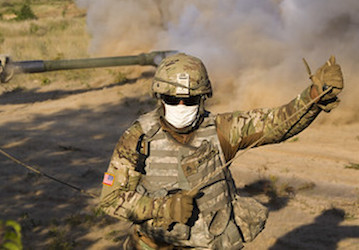In order to limit the spread of the COVID-19 virus, wearing a face mask has been adopted as a best practice. Few question the effectiveness of face masks or other coverings to limit the spread of the COVID-19 virus by droplets, but we have been asked several questions about their use. We offer answers here.
Does wearing a face covering or mask in training impair the body's thermoregulatory mechanisms (the body’s ability to regulate its temperature)?
Your body loses heat when you breathe (which helps keep your body from overheating), but a face mask covers so little of the body’s surface area that the effect on heat loss is minimal. A typical mask—such as a cloth, disposable surgical, or N95 mask—covers 1% of the body’s surface area, and only 1% of your body’s heat loss by evaporation occurs on your face.
Heat loss due to respiration is reduced as humidity and environmental heat increase, and both of these are relative to the amount of heat your body loses. For example, at 77°F and 50% relative humidity, around 9% of body heat is lost through respiration. At 95°F and 80% relative humidity, that value falls to 2.2% of body heat. Environmental conditions such as the latter occur at many military installations throughout the summer months. Thus, wearing a face mask or other face covering does not compromise your body’s ability to regulate internal temperature during exercise.
Does wearing a face mask increase the risk and rate of sustaining heat illness?
No, there is no direct relation between wearing a face mask and thermoregulation, as discussed above. However, it is more difficult to drink while wearing a face covering. To prevent dehydration, it is important to take periodic breaks and drink fluids. Read HPRC’s article on staying hydrated to learn more.
Do face masks or coverings impair the ability of cadre and leaders to recognize early signs and symptoms of heat illness?
The answer to this question is: possibly. That’s because facial expressions of pain and discomfort are more difficult to observe when a portion of the face is covered by a mask. Exertional heat stroke symptoms include a core temperature above 40°C (104°F) and central nervous system dysfunction (altered mental status, loss of consciousness, seizures, etc.). For additional information on heat illness recognition and treatment, read HPRC’s Unpacking “heat illness” and the HPRC heat acclimatization blog.
Does a face covering impact how an individual perceives heat?
Research has shown that many people are more uncomfortable due to facial heat when wearing a face mask for 30 minutes or more during exercise compared to being unmasked. In addition, wearing a mask can make you feel more heat stressed than when you’re unmasked. However, research also has shown that this perception is not accompanied by an actual change in body temperature and heart rate. Therefore wearing a face mask does not contribute to heat illness.
Best personal safety practices during COVID-19
- Maintain social distancing (physical separation of at least 6 feet) as much as possible. Break up Military Service Members into smaller groups to allow for this spacing. If proper social distancing is maintained during physical training outdoors, whether alone or in groups, wearing a face mask is not necessary.
- Avoid being directly behind another person. Run or exercise side by side or in a staggered formation.
- Any face covering, whether a cloth face covering or NIOSH-approved respirator, is designed for protection, not comfort. There is no “best fabric.” The recommendation for a cloth face mask continues to be two layers of closely woven cotton fabric. To learn more about cloth face coverings, check out the CDC’s article About Cloth Face Coverings.
